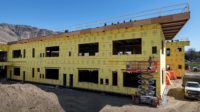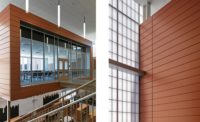An old adage proclaims “If you want something done right, do it yourself.” Doing it all would be virtually impossible in today’s commercial construction where complex building systems, vast arrays of material choices, design configurations, and countless other variables require more expertise than anyone could ever muster alone. Though doing it all isn’t within reason, John Calacci of Calacci Construction in Iowa City, Iowa, maintains an admittedly old-school work ethic.
“We’re an old fashion general contractor,” says Calacci. “We like to do our own work.”
Calacci Construction generally places concrete and sets steel for all of their projects, they then tackle framing, roofing, insulation, and subcontracts work only when their internal expertise meets its limits. It helps that the company owns much of the required heavy equipment. As a union contractor, the firm has access to hiring halls to support a peak employment of as many as 150 tradespeople. Calacci also works closely with a variety of apprentice programs to hire and train multiple trades. He acknowledges the difficulty of hiring the talent needed to perform the work in-house, but sees a lot of positives for his clients in this approach.
“Self-performing as much as we do gives us comprehensive control over everything—quality, safety, schedule, cost and profit,” continues Calacci, whose company has been growing since he started it in 2008. Today, Calacci Construction has an annual volume of roughly $30 million, picking up projects throughout eastern Iowa in multiple sectors, such as Industrial, Healthcare, Municipal and Commercial. “Ultimately, tight control results in great efficiency, which is something we value a lot.”
Room to Grow
Calacci’s appreciation for long-term efficiency was the driving factor in most design and construction decisions when it came time to construct his own new company offices. After a few years of leasing office space and telecommuting, constructing an office allowed Calacci to get everyone under one roof with room to grow.
Completed in the spring of 2016, the new, 15,800-square-foot office building was configured on two floors, with mechanical systems located in the basement. The main building is accompanied by an 11,900-square-foot shop along with ample site storage and space for equipment, materials, and staging, all of which were planned for functionality and accessibility for daily use.
Thinking beyond initial costs, Calacci was interested in building strategies that would help him reduce operating expenses during Iowa’s hot summers and cold winters. A great first step was to take advantage of the site’s ability to tap into geothermal heating through a ground source heat pump. Using horizontal wells drilled between 15 and 30 feet deep, the pump circulates fluid through plastic pipes in the wells, which are either heated or cooled by the earth depending on the season. The Calacci Construction building maintains a steady 57 or 58 degrees, circulating cooler air in summer and warmer air in winter. Along with the heat pump, the new building also benefits from a high performance thermal envelope, which helps maintain constant temperatures despite external conditions.
“We wanted a good tight seal on the building; we sourced all the materials from within 50 miles or so; we used recycled concrete and such; but for us it’s more about efficiency than being particularly green,” says Calacci. Because the architecture combines a glass curtain wall with punched window masonry, a tight seal required a bit of precision in materials and workmanship. “To meet the new UBC building code, walls have to have a complete thermal break, so we needed a masonry cavity insulation. We chose ACH Foam Technologies for several reasons,” continues Calacci. “Of course, they are local, about 30 miles from here, but their products also come in a wide range of thicknesses, which really helped us fill in around some complex architectural detailing.”
The masonry face of the building lifts out and dips in and around, long vertical sections of glass, a well-executed undulation from solid to transparent and back. Calacci explains that some cavity sections were as much as 6 inches of void space, while other sections were only 2 inches of space.
Loads of Insulation
Working with their local White Cap representative, Calacci purchased 19,200 board-feet of Foam-Control PLUS+ 250 scored architectural insulation, which provides a mid 20s R-value according to Calacci’s estimates. The product is designed to give architects, designers and contractors the strength, energy efficiency and moisture resistance of a high quality insulation at a budget-friendly price. Purchasing a pre-scored product allowed Calacci’s installers to easily create custom lengths simply by bending the insulation board along the perforations and snapping it into pieces.
Calacci explains that he had previous experience working with ACH, recalling his work on the new Children’s Hospital in Iowa City. Large Geofoam blocks had been used as a lightweight structural fill between an underground parking structure and a roadway plaza built above, giving Calacci an appreciation for EPS’ high compressive strength and durability. His team toured the local plant and met with ACH’s estimators to develop shop drawings and review technical assembly details. This knowledge and confidence helped to make selecting the manufacturer an easy choice for supplying vertical insulation for his own building.
While many of the cost-effective sustainable strategies Calacci Construction employed on their project are common place, there was one application that was a first for them. Adjacent to the new office sits Calacci’s 11,900-square-foot shop, which includes 7,000 square feet of heated space using an in-floor radiant heating system. To maximize the thermal benefits, Calacci Construction did a little innovating.
“We figured out how to embed two inches of Foam-Control PLUS+ insulation within a cast in-place concrete wall,” says Calacci proudly. Creating a 12-inch thick Symons pan-wall four feet up from the foundation, Calacci used two steel rebar grids and center-facing slab boosters to sandwich a layer of insulation into the formwork.
“We’ve created a thermal break along the foundation walls that extends up 4 feet above the floor but we don’t have any caulk joints to maintain the way you would with insulated precast panels,” he says.
While doing it all alone is generally a thing of the past in commercial construction, it’s good to know there are still a few old-school builders out there putting their own new twist on the way things get done.








Report Abusive Comment